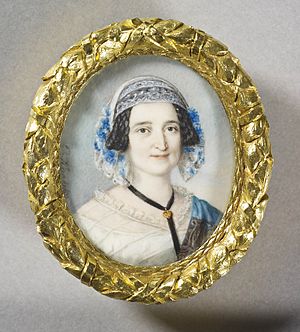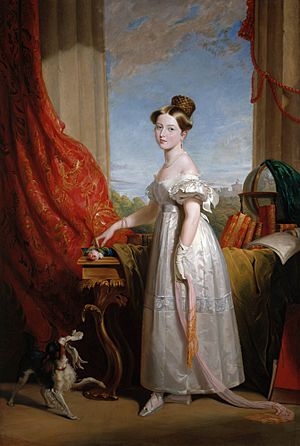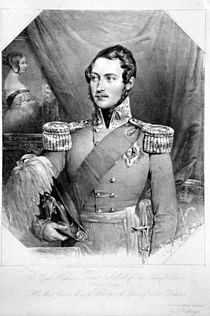Louise Lehzen facts for kids
Quick facts for kids
Louise Lehzen
|
|
|---|---|

Painted by Carl Friedrich Koepke for Queen Victoria, c. 1842
|
|
| Born |
Johanna Clara Louise Lehzen
3 October 1784 |
| Died | 9 September 1870 (aged 85) Bückeburg, Principality of Schaumburg-Lippe
|
| Known for | Governess, adviser and companion to Queen Victoria |
| Title | Baroness |
Johanna Clara Louise Lehzen (3 October 1784 – 9 September 1870), also known as Baroness Louise Lehzen, was a special teacher and friend to Queen Victoria of the United Kingdom.
Born in Germany, Louise Lehzen began working for the Duke of Kent in 1819. Five years later, she became the teacher for his only child, Princess Alexandrina Victoria. This young princess would later become Queen Victoria. In 1827, Victoria became second in line to the British throne.
Victoria's childhood was very strict due to the "Kensington System." This system was created by her widowed mother, the Duchess of Kent, and her manager, Sir John Conroy. Lehzen was very protective of Victoria. She encouraged the princess to be strong and think for herself, away from her mother and Conroy's control. This caused many arguments in the royal home.
Attempts to remove Lehzen failed because Victoria's royal uncles supported her. Soon, "dear, good Lehzen" became the most important person to Victoria, even more than her own mother. When Victoria became queen in 1837, Lehzen became her unofficial private helper. She even had rooms next to Victoria's.
However, when Victoria married Prince Albert in 1840, things changed. Albert and Lehzen did not like each other. After Victoria's first child became ill in 1841, Lehzen was asked to leave. Their close friendship ended, but they still wrote letters to each other. Lehzen spent her last years in Germany with a good pension. She died in 1870. Lehzen greatly influenced Victoria's character, helping her become a strong queen.
Contents
Early Life and Royal Role
Johanna Clara Louise Lehzen was born in Hanover, Germany, on 3 October 1784. She was the youngest of ten children. Her father was a Lutheran pastor. From a young age, Lehzen had to work to support herself. She worked as a teacher for three daughters in a German noble family. She received excellent reviews for her work.
In December 1819, Lehzen joined the household of Princess Victoria, Duchess of Kent. She became the teacher for Princess Feodora, who was twelve years old. Feodora was the Duchess's daughter from her first marriage. The Duchess had married Prince Edward Augustus, Duke of Kent and Strathearn. He was fourth in line to the British throne.
Lehzen and the royal household moved to England in 1817. This was so the Duchess's new baby could be born in England. This would strengthen the baby's claim to the throne. The baby was a girl named Alexandrina Victoria. She would later become Queen Victoria.
Becoming Princess Victoria's Teacher
The Duke of Kent died suddenly in 1820. His father, King George III, also died soon after. Victoria's uncle became King George IV. Victoria was now third in line to the throne. Her uncles, the Duke of York and the Duke of Clarence, were older and had no children. This meant Victoria was likely to become queen.
Because of this, Victoria needed a special education. Feodora was now 14 and no longer needed a teacher. In 1824, Lehzen took over the care of five-year-old Victoria. The Duchess of Kent and her manager, John Conroy, chose Lehzen because she was German. They also thought she would follow their rules.
Historian Christopher Hibbert described Lehzen as "clever, emotional, humourless." At first, Victoria found Lehzen's manner strict. But soon, "dear, good Lehzen" became the most important person in Victoria's life. Victoria loved Lehzen more than her own mother. Lehzen encouraged the princess to be independent. She also taught Victoria to be careful of her mother and her mother's friends.
Lehzen was not interested in money or power for herself. She focused all her energy on the princess. Victoria privately called Lehzen "Mother" and "dearest Daisy." She wrote that Lehzen was "the most affectionate, devoted, attached, and disinterested friend I have."
As part of the strict "Kensington System," Lehzen had to be with Victoria all day. She could not leave Victoria's side until the Duchess dismissed her at night. She even had to hold Victoria's hand when the princess walked down stairs.
Lehzen Becomes a Baroness
In 1827, the Duke of York died. This made the Duke of Clarence the next in line, and Victoria second in line to the throne. King George IV worried if Lehzen was the right person to prepare Victoria. To help, Victoria's mother and Conroy convinced the king to give Lehzen a special title. This was so the princess would not be surrounded only by common people. Lehzen became a baroness of the Kingdom of Hanover.
King George IV died in 1830. His brother, the Duke of Clarence, became King William IV. King William officially recognized Victoria as his heir. Lehzen later told a famous story about this time. She secretly put a family tree of the House of Hanover into one of Victoria's school books. After looking at it, Victoria realized her father had been next in line after the king. She also saw that Queen Adelaide had no living children.
This was the first time Victoria truly understood that she would be the next British queen. After a moment, Victoria reportedly said, "I will be good." This story became a popular legend for future generations.
In 1831, King William appointed the Duchess of Northumberland as Victoria's official teacher. But this role was mostly for show. Victoria continued to rely on Lehzen. In 1837, Victoria's mother dismissed the Duchess. This was because the Duchess tried to have more say in Victoria's education. During this time, Lehzen had no official court position. Even with her new title, her common background was still a problem.
Teaching Princess Victoria
The Duchess and Conroy wanted Victoria to depend on them. But Lehzen worked against this. She wanted Victoria to become a strong, knowledgeable woman. As Victoria grew older, Conroy and the Duchess tried to remove Lehzen or lessen her influence. But they failed. The princess became even more devoted to Lehzen, as seen in her personal diaries.
Lehzen's only true friend in the household was Baroness Spath. She was suddenly dismissed in 1828 by Conroy. People rumored that the baroness had seen something improper between Conroy and the Duchess. Some at King George IV's court thought Lehzen would be next to leave. But Lehzen stayed quiet and kept her position.
In 1835, the Duchess of Kent wrote a strict letter to her daughter. She demanded that Victoria have a more formal relationship with Lehzen. That same year, when Victoria turned sixteen, plans to dismiss Lehzen fell apart. This was because Lehzen lovingly cared for Victoria during a five-week illness. Lehzen helped a weak Victoria refuse to sign a document. This document, prepared by Conroy and the Duchess, would have given Conroy a special position when Victoria became queen.
During her time as Victoria's teacher, Lehzen had the support of King George IV, King William IV, and Victoria's uncle, Leopold I of Belgium. They all believed she was important for the princess's health, happiness, and resistance to Conroy's influence.
The education Victoria received from Lehzen was basic but strong. Unlike common beliefs at the time, Lehzen and other teachers encouraged Victoria to enjoy learning. Teacher Dr. George Davys taught Victoria "solid" subjects. Lehzen focused on "more ornamental" subjects, like dancing. Victoria received an "enlightened education." She learned to speak French, German, Latin, and English. She liked history and studied economics, geography, mathematics, politics, art, and music. Lehzen was strict but rewarded Victoria when she was obedient. Also, Lehzen rarely used physical punishment, which was unusual for the time.
Queen Victoria's Reign
When Victoria became queen in 1837, Lehzen had an important place at the coronation. She stayed at court. Lehzen asked for no official position. Instead, she agreed to a new title: "lady attendant." She lived at Buckingham Palace as an unofficial private helper. She managed the royal homes and held the household keys. Her signature was needed for all payments to tradesmen.
At this point, Lehzen seemed to have completely replaced Victoria's mother. Lehzen's rooms were next to the queen's. The Duchess of Kent's rooms were far away from Victoria's. For the first few years of Victoria's reign, Lehzen had a very strong influence on the queen. This was especially true before Victoria married Prince Albert in 1840. Lehzen did not openly get involved in state matters. But she influenced Victoria's views on politics and personal issues. Even after the queen married, Lehzen kept a private doorway into the royal bedroom. This bothered Victoria's new husband.
Prince Albert's Influence
Prince Albert's arrival brought big changes to Victoria's household. Lehzen had not wanted Victoria to marry Albert. She believed the princess should be like a "second Queen Elizabeth, independent of male influence." Albert was very educated. He had traveled across Europe and studied at the University of Bonn. He was shocked by some of the things he saw at Victoria's court.
Lehzen and Albert quickly disliked each other. She often went against Albert's wishes in running the household. Albert found her unpleasant and unworthy of being the queen's friend. He openly called her "the hag" and a "crazy stupid intriguer."
When Victoria's first child, the Princess Royal, was born, Victoria trusted Lehzen to arrange the nursery. Lehzen put the nursery in the care of various staff and Sir James Clark. Albert disagreed, saying the doctor was not suitable. Dr. Clark had made mistakes before, during the Lady Flora Hastings issue a year earlier.
When the Princess Royal was fourteen months old, she became ill. She lost her appetite and looked pale and feverish. Dr. Clark said it was a minor illness. He wrongly gave her medicine that contained mercury. In reality, the princess was likely upset by changes in the royal nursery. Her younger brother had just arrived. Albert, who was a very caring father, confronted Victoria about the staff Lehzen had chosen. They had an argument. Albert said he would leave the matter to Victoria, but if the child died, it would be on her conscience.
Soon after this argument, Victoria agreed with her husband. She did not want him to be unhappy. She tried one last time to defend Lehzen. She described Lehzen as a loyal woman who deserved to stay close to her former student. But Albert was firm. Victoria dismissed Lehzen, saying it was for Lehzen's health. Albert believed Lehzen was a servant who had tried to rise above her place. He wanted Victoria to rely only on him. Lehzen accepted the reason of ill health and agreed to leave.
In the days before she left, Lehzen taught some of her duties to Marianne Skerrett, one of Victoria's dressers. She returned her keys to the queen. Lehzen left on 30 September 1842. She left a note instead of speaking directly with Victoria, thinking it would be less painful. The queen was sad about Lehzen's absence. She had spent almost her whole life with her former teacher. "It was very painful to me... waking this morning, and recollecting she was really quite away," Victoria said.
News of Lehzen's departure spread. People gave different reasons for her leaving. The court diarist Charles Greville wrote she was leaving "for her health (as she says), to stay five or six months, but it is supposed never to return." The Times newspaper reported she was simply visiting friends in Germany. After she left, family adviser Baron Stockmar said that Albert had a hard time getting rid of Lehzen. He said she was foolish to challenge Albert's influence.
Later Life and Legacy
When Lehzen left the court, she returned to her home country, Germany. She lived in Bückeburg with her sister. Victoria gave her a generous pension of £800 each year. Lehzen covered the walls of her house with portraits of the queen. Her sister died a few months later. But Lehzen continued to financially support her many nieces and nephews.
Lehzen always cared for Victoria. The queen wrote to her former teacher regularly, first weekly, then monthly. When Victoria visited relatives in Germany, she visited Lehzen twice in private. Baroness Lehzen died in Bückeburg on 9 September 1870. She is buried in Jetenburger cemetery. Queen Victoria ordered a memorial to be built for her.
After Lehzen's death, Queen Victoria spoke of her thanks for their relationship. But she also said that "after I came to the throne she got to be rather trying, and especially so after my marriage... [This was not] from any evil intention, only from a mistaken idea of duty and affection for me."
During her time at the British court, Lehzen gained attention for her close bond with Victoria. Some people criticized her influence, especially those who disliked German influences at court. Pamphlets, many from the Tory party, complained about the "stranger harboured in our country" and the "evil counsellors" around Victoria. One pamphlet even linked Lehzen to a "conspiracy" regarding the Lady Flora Hastings affair.
More positively, The Times once described her as simply holding "a highly and strictly confidential situation about the person of the Sovereign." As a sign of her perceived political power, false rumors in 1838 suggested Lehzen had joined the Whig party. It was even rumored that Whig prime minister Viscount Melbourne had proposed marriage to her.
Despite this criticism, historian Gillian Gill says Lehzen was honest and careful with money. Even after Victoria became queen, Lehzen did not ask for more money or a higher rank. She simply wanted to be with the queen. Historian K. D. Reynolds adds that Lehzen greatly influenced Victoria's character. She especially gave the queen the strength to overcome her difficult childhood and early years as queen. However, not all her influence was positive. Reynolds also thinks that the 1839 Bedchamber crisis partly came from Victoria's unwillingness to let Lehzen go.
Baroness Lehzen has been shown many times in movies and TV shows. She was played by Renée Stobrawa in the 1936 German film Mädchenjahre einer Königin. Greta Schröder played her in Victoria the Great and Sixty Glorious Years. Barbara Everest played her in 1941's The Prime Minister. Magda Schneider was Lehzen in the 1954 TV show The Story of Vickie. Olga Fabian played her in an episode of Hallmark Hall of Fame. Patience Collier was Lehzen in Edward the Seventh. Diana Rigg played her in the 2001 TV show Victoria & Albert. Jeanette Hain played her in the 2009 film The Young Victoria. And Daniela Holtz played her in the 2016 TV series Victoria.




